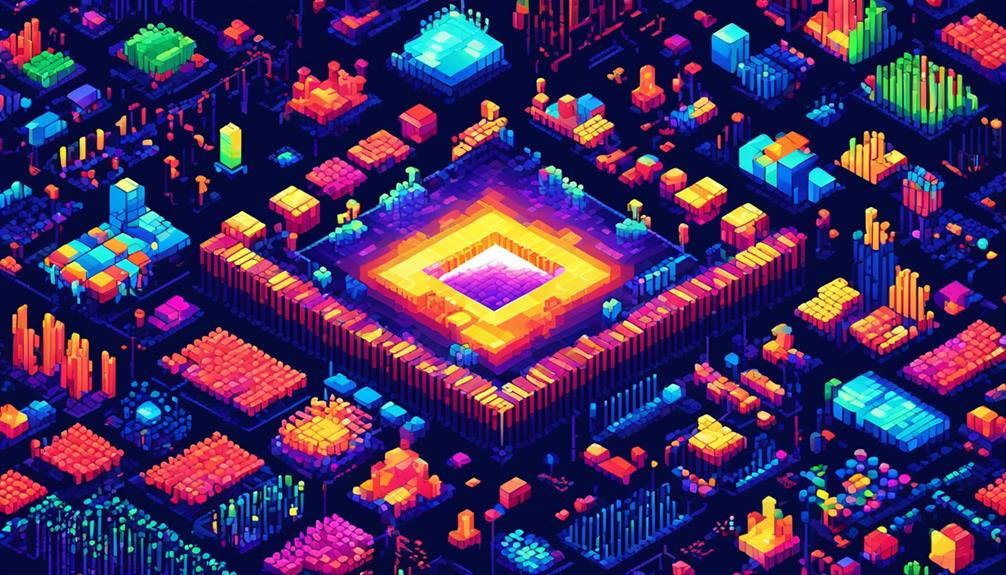Fiber optic technology has witnessed remarkable advancements that have revolutionized the communications landscape. From the introduction of low-loss optical fiber in 1970 to the development of cutting-edge products by industry leader, Corning, such as single-mode fiber and dispersion-shifted fiber, these innovations have paved the way for transformative technologies like 5G, artificial intelligence, and virtual reality.
The continuous evolution of optical fiber has enabled the seamless transmission of vast amounts of data at unprecedented speeds, facilitating the rise of the Internet of Things and augmented and virtual reality. As we delve into the realm of fiber optic advancements, we are poised to uncover the game-changing developments and promising research that will shape the future of telecommunications.
Key Takeaways
- Fiber optic technology has revolutionized communication infrastructure by replacing copper wire with low-loss optical fiber.
- Corning has played a significant role in the innovation of the optical fiber industry, including the development of single-mode fiber, Germania-doped silica glass, and dispersion-shifted fiber.
- Advancements in optical fiber technology have enabled the deployment of 1 billion kilometers of fiber by Corning and have facilitated the development of technologies like 5G and virtual reality.
- Cutting-edge fiber optic systems, including single-mode fiber and Germania-doped silica glass, have contributed to improved performance and reliability in communication networks, supporting emerging technologies like the Internet of Things and augmented and virtual reality.
Fiber Optic Materials Advancements

Fiber optic materials advancements have revolutionized communication infrastructure by replacing copper wire, thanks to their development of low-loss optical fiber. These advancements have paved the way for faster and more efficient data transmission, enabling the growth of various technologies and applications.
One company that has played a crucial role in the innovation of the optical fiber industry is Corning. Their expertise and continuous research and development have resulted in significant breakthroughs. They were instrumental in the development of the first single-mode fiber, Germania-doped silica glass, and dispersion-shifted fiber. These advancements have greatly improved the performance and reliability of optical fiber, supporting technologies like 5G and virtual reality.
The continuous evolution of optical fiber has also enabled the rise of technologies such as the Internet of Things and augmented and virtual reality. Corning, in particular, has reached a milestone of deploying 1 billion kilometers of optical fiber, demonstrating their commitment to pushing the boundaries of communication technology.
Corning ensures manufacturing excellence through their proprietary processes, stringent performance and reliability standards, and customer-centric support. This commitment to quality sets them apart in the industry, making them a trusted partner for telecommunication companies.
The optical fiber products offered by Corning provide unmatched bandwidth potential and performance. They are at the forefront of communication technology, making innovation crucial for progress and development in the telecoms market. Through their advancements in fiber optic materials, Corning continues to drive the industry forward, facilitating faster, more reliable, and more efficient communication systems.
Cutting-Edge Fiber Optic Systems
Cutting-edge advancements in optical fiber technology have revolutionized communication infrastructure, enabling faster and more efficient data transmission and supporting the growth of various technologies and applications. One of the key drivers for these advancements is the development of cutting-edge fiber optic systems.
Corning, a leading company in the optical fiber industry, has been at the forefront of innovation in fiber optic systems. They have developed several groundbreaking technologies that have significantly improved the performance and capabilities of fiber optic communication.
For instance, Corning introduced the first single-mode fiber, which allows for the transmission of a single mode of light, enabling higher data rates and longer transmission distances. Additionally, they pioneered the use of Germania-doped silica glass, which reduces signal loss and improves the overall quality of the transmitted data.
Another important development in cutting-edge fiber optic systems is dispersion-shifted fiber. This type of fiber minimizes the dispersion of light signals, allowing for longer transmission distances without significant signal degradation. This is particularly important for long-haul telecommunications applications.
Furthermore, the continuous innovation and development in fiber optic systems have led to the creation of fiber optic cable assemblies made from materials such as silica and plastic. These materials contribute to the impressive performance and reliability of fiber optic systems.
The fast pace of innovation in the telecoms market has led to a growing importance of fiber networks in various industries. The increasing demand for higher data rates and bandwidth has driven the development of cutting-edge fiber optic systems, enabling the deployment of emerging technologies like the Internet of Things and augmented and virtual reality.
Revolutionary Fiber Optic Technologies

Revolutionary fiber optic technologies have brought about significant advancements in speed and increased bandwidth. These innovations have paved the way for faster and more efficient communication systems, enabling the seamless transmission of large volumes of data.
With these advancements, industries such as telecommunications, artificial intelligence, and virtual reality have been able to thrive, opening up new possibilities for technological development and enhancing the overall user experience.
Speed Enhancements
The rapid advancements in optical fiber technology have ushered in a new era of speed enhancements, revolutionizing the transmission and communication of data. These advancements have significantly increased the capacity and capabilities of optical fiber, enabling it to carry more information at greater speeds. The table below highlights some of the key speed enhancements in fiber optic technology:
| Fiber Optic Technology | Description | Benefits |
|---|---|---|
| Single-mode fiber | Uses a smaller core to transmit data | Allows for faster Internet speeds over longer distances |
| Dispersion-shifted fiber | Reduces the dispersion of light signals | Enables higher data rates and longer transmission distances |
| Wavelength division multiplexing (WDM) | Transmits multiple data streams simultaneously | Increases data capacity and overall speed |
| Polarization-maintaining fiber | Maintains the polarization of light signals | Ensures stable and reliable data transmission |
| Coherent optical communication | Utilizes advanced modulation and detection techniques | Enables higher data rates and longer transmission distances |
These speed enhancements in fiber optic technology have paved the way for faster Internet speeds, supporting the growing demand for bandwidth-intensive applications and driving innovation across various industries.
Increased Bandwidth
With the advancements in speed enhancements, fiber optic technology has now paved the way for revolutionary breakthroughs in increased bandwidth, transforming the landscape of data transmission and communication.
Increased bandwidth in fiber optic technology allows for faster and more efficient data transmission, enabling the transfer of large amounts of data at incredibly high speeds. This revolutionary technology has greatly enhanced the performance and capabilities of communication networks.
The higher bandwidth in fiber optics supports the development and utilization of bandwidth-intensive technologies like 5G, artificial intelligence, and virtual reality. It is crucial for meeting the growing demands of modern communication systems and applications.
Latest Innovations in Fiber Optic Communication
The latest innovations in fiber optic communication have focused on two key areas: speed advancements and enhanced signal quality.
Speed advancements involve increasing the data transmission rates of fiber optic cables, allowing for faster and more efficient communication.
Enhanced signal quality refers to improvements in the clarity and reliability of the transmitted signals, resulting in better overall performance.
These innovations have greatly contributed to the evolution and expansion of fiber optic technology, enabling it to meet the growing demands of modern communication systems.
Speed Advancements
Advancements in fiber optic communication have revolutionized the speed at which data can be transmitted and processed across industries.
Speed advancements in fiber optic technology have played a crucial role in meeting the ever-increasing demand for high-speed data transmission. With the rise of 5G networks and the Internet of Things (IoT), the need for faster and more efficient data transfer has become paramount.
Fiber optic cables, with their ability to transmit data at the speed of light, have become the backbone of modern communication systems. These cables offer unparalleled speed, allowing for the transmission of large amounts of data in a fraction of a second.
As a result, industries such as telecommunications, healthcare, and aerospace are benefiting from faster and more reliable communication, enabling them to enhance their operations and deliver services more efficiently.
The continuous advancements in speed capabilities of fiber optic technology are driving innovation and shaping the future of various industries.
Enhanced Signal Quality
Innovations in fiber optic communication have led to significant enhancements in signal quality, enabling higher data transmission rates and improved reliability. These advancements are crucial for supporting emerging technologies such as 5G, artificial intelligence, and Internet of Things (IoT) applications.
Enhanced signal quality in fiber optic communication is achieved through the latest innovations in fiber optic technology, including advanced signal processing algorithms and improved laser technologies. These innovations aim to minimize signal loss, reduce interference, and optimize signal strength for seamless and efficient data transmission.
Fiber optic cables play a vital role in maintaining signal quality by providing a high-speed, low-latency pathway for transmitting data over long distances.
Breakthroughs in Fiber Optic Data Transmission

Breakthroughs in fiber optic data transmission have transformed communication infrastructure, replacing traditional copper wire systems and enabling technologies such as the Internet of Things and augmented reality. The continuous evolution of fiber optic technologies has resulted in increased data capacity and faster transmission speeds, revolutionizing the way we communicate and interact with technology.
Corning, a prominent player in the industry, has made significant contributions to the development of fiber optic data transmission. Their innovations in single-mode fiber and dispersion-shifted fiber have supported the advancement of technologies like 5G, artificial intelligence, and virtual reality. These breakthroughs have paved the way for faster and more reliable data transmission, making it possible to handle the massive amounts of data generated by these emerging technologies.
Manufacturing excellence and stringent quality standards ensure that Corning's optical fiber products offer unmatched bandwidth potential and performance. This reliability is crucial in enabling seamless communication and data transfer, especially in critical applications such as healthcare, finance, and transportation.
The constant innovation in the fiber optics industry fuels the rapid growth and evolution of high-speed data transmission technologies. As the demand for faster and more efficient data transmission increases, manufacturers have ample opportunities to capitalize on this market demand. This has led to the development of new fiber optic technologies, such as flexible fibers and hollow-core fibers, which promise even higher data rates and improved performance.
Advancements in Fiber Optic Network Infrastructure
Advancements in fiber optic network infrastructure have led to significant improvements in network speed and enhanced data transmission capabilities.
With the continuous evolution of fiber optic technology, networks are now able to carry more information and reach higher speeds, enabling faster and more reliable data transfer.
These advancements have paved the way for the development of technologies like 5G and virtual reality, further expanding the possibilities of fiber optic networks in various industries.
Network Speed Improvements
The speed and efficiency of network communication have been significantly enhanced through advancements in fiber optic network infrastructure.
Innovations in fiber optic technology have revolutionized industries, enabling real-time data analytics, remote monitoring, virtual collaboration, and high-definition video conferencing. These advancements have been driven by improvements in data transmission rates and bandwidth capacity.
Fiber optic cables, with their ability to transmit data using light signals, offer significantly higher data transfer rates compared to traditional copper cables. This has led to faster and more reliable data transfer, supporting the growing demand for data-intensive applications and services.
The evolution of fiber optic network infrastructure has also resulted in reduced latency, ensuring faster response times, and improved network performance. These improvements meet the increasing demands of modern digital communication, enabling seamless connectivity and high-speed internet access.
Enhanced Data Transmission
Enhanced data transmission in fiber optic networks is achieved through continuous innovation and refinement of infrastructure design and technology. Advancements in fiber optic network infrastructure have significantly increased the speed and capacity of data transmission.
These advancements have paved the way for the development of technologies like 5G, artificial intelligence, and virtual reality. Fiber optic technology enables high-speed, reliable, and secure data transmission over long distances.
This enhanced data transmission capability has enabled the Internet of Things and augmented and virtual reality applications, transforming various industries and sectors. With virtually unlimited capacity and capabilities, fiber optic technology has revolutionized the way data is transmitted, enabling seamless communication and connectivity in our increasingly digital world.
As technology continues to evolve, further advancements in fiber optic network infrastructure will continue to enhance data transmission capabilities, driving innovation and progress in numerous fields.
Next-Generation Fiber Optic Connectivity Solutions

Next-Generation Fiber Optic Connectivity Solutions drive advancements in automation, robotics, and AI in factories and warehouses. These solutions offer unparalleled speed with symmetrical upload and download speeds, making them the gold standard for delivering internet connectivity. With their high bandwidth capabilities, they are crucial for the development of high-speed 5G Internet globally. This next-generation technology has the capacity and scalability to accommodate future technological advancements, ensuring its relevance in the ever-evolving digital landscape.
In various industries, including telecommunications, healthcare, and aerospace, Next-Generation Fiber Optic Connectivity Solutions are widely adopted due to their reliability and immunity to electromagnetic interference. This makes them ideal for critical applications that require secure and uninterrupted data transmission. These solutions provide a robust infrastructure for industries to leverage automation, robotics, and AI, enabling increased efficiency and productivity.
The future of Next-Generation Fiber Optic Connectivity Solutions holds exciting prospects. Advancements in cable assembly designs are paving the way for smaller, more durable cables with higher data-carrying capacity. This not only enhances the performance of the fiber optic network but also opens up ample opportunities for manufacturers to capitalize on the growing fiber optic market. As the demand for faster and more reliable connectivity continues to rise, the development of next-generation solutions will play a pivotal role in meeting these needs.
Emerging Trends in Fiber Optic Technology
Emerging trends in fiber optic technology are revolutionizing various industries, including telecommunications, healthcare, and aerospace. As the demand for faster and more reliable data communication continues to grow, advancements in fiber optic technology are paving the way for innovative solutions.
One of the emerging trends in fiber optic technology is the development of smaller and more durable cable assembly designs. Manufacturers are focusing on creating compact and flexible cables that can withstand harsh environments while still providing high data-carrying capacity. These advancements in cable design are crucial in meeting the increasing demands of industries such as telecommunications and aerospace, where space and durability are key considerations.
The rise of 5G networks and the Internet of Things (IoT) is another driving force behind the emerging trends in fiber optic technology. With the deployment of 5G networks, there is a need for high-speed and low-latency communication, which can be achieved through fiber optic cable assemblies. Additionally, the growing number of connected devices in the IoT ecosystem requires a robust and reliable network infrastructure, making fiber optics an ideal choice.
The global fiber optic market is projected to reach a value of $9.12 billion by 2025, indicating ample opportunities for manufacturers to capitalize on the growing demand. To stay competitive, companies are investing in research and development to innovate and offer cutting-edge solutions in fiber optic technology. By staying at the forefront of emerging trends, manufacturers can provide their customers with improved performance, reliability, and efficiency.
Disruptive Innovations in Fiber Optic Industry

The rapidly evolving fiber optic industry has witnessed disruptive innovations that have revolutionized various sectors, including automation, robotics, and AI, by enabling high-speed data transmission and supporting the development of technologies such as 5G, artificial intelligence, and virtual reality.
One disruptive innovation in the fiber optic industry is the development of high-capacity optical fibers. These fibers have significantly increased the data transmission capacity, allowing for faster and more efficient communication networks. This innovation has facilitated the growth of technologies like 5G, which require high-speed data transmission for applications such as autonomous vehicles, smart cities, and IoT devices.
Another disruptive innovation is the advancement in fiber optic cable assemblies. These assemblies are crucial for the development of high-speed 5G internet globally and are widely adopted in various industries, including telecommunications, healthcare, and aerospace. The use of fiber optic cable assemblies has enabled faster and more reliable communication, leading to improved efficiency and productivity in these sectors.
Additionally, the implementation of fiber-to-the-home (FTTH) technology has been a game-changer in the industry. FTTH has become the gold standard for delivering internet connectivity, offering unparalleled speed, reliability, and scalability. This innovation has opened up possibilities in smart cities, telemedicine, remote work, and education, transforming the way we live and work.
Future of Fiber Optic Telecommunications
With the rapidly evolving fiber optic industry driving advancements in high-speed data transmission and supporting technologies like 5G and the Internet of Things, the future of fiber optic telecommunications holds immense potential for smaller, more durable cable assembly designs with high data-carrying capacity.
One of the key developments in the future of fiber optic telecommunications is the focus on smaller and more durable cable assembly designs. These advancements are driven by the need to accommodate the increasing demand for high-speed data transmission in various industries, including telecommunications, healthcare, and manufacturing. Smaller cable assemblies not only reduce installation costs but also provide greater flexibility in network design and deployment.
In addition to smaller designs, the future of fiber optic telecommunications also involves increasing the data-carrying capacity of fiber optic cables. This is crucial to meet the growing demand for bandwidth-intensive applications and services. Manufacturers are investing in research and development to enhance the capacity of fiber optic cables, enabling them to handle higher volumes of data traffic without compromising on speed or reliability.
To illustrate the potential impact of these advancements, let's consider the following table:
| Advancements | Benefits |
|---|---|
| Smaller cable assembly designs | – Lower installation costs<br>- Greater flexibility in network design |
| Increased data-carrying capacity | – Accommodate growing demand for bandwidth-intensive applications<br>- Maintain high-speed and reliable data transmission |
The global fiber optic market is projected to reach a value of $9.12 billion by 2025, indicating significant opportunities for manufacturers to capitalize on the growing demand for fiber optic telecommunications. However, challenges in fiber to the home (FTTH) deployment, such as infrastructure investment, addressing the digital divide, regulatory frameworks, skills development, and shared responsibility, need to be addressed to ensure widespread adoption and accessibility.
Game-Changing Technologies in Fiber Optics

Game-Changing Technologies in Fiber Optics revolutionize the telecommunications industry by introducing cutting-edge advancements in data transmission and connectivity. These technologies have transformed the way information is transmitted and have paved the way for the development of new applications and services.
Here are three game-changing technologies in fiber optic technology:
- Low-loss optical fiber: The discovery of low-loss optical fiber in 1970 revolutionized the communications landscape by replacing copper wire infrastructure. This breakthrough allowed for the efficient transmission of data over long distances without significant loss in signal quality. Low-loss optical fiber has been instrumental in enabling high-speed internet connections and has become the backbone of modern telecommunications networks.
- Single-mode fiber: Corning's development of the first single-mode fiber has been a major game-changer in the industry. Single-mode fiber allows for the transmission of a single mode of light, resulting in higher bandwidth and longer transmission distances. This technology has supported the development of technologies like 5G, artificial intelligence, and virtual reality, which require high-speed and reliable data transmission.
- Dispersion-shifted fiber: Dispersion-shifted fiber is another significant advancement in fiber optic technology. This type of fiber is designed to minimize signal distortion caused by dispersion, allowing for the transmission of data at higher speeds over longer distances. Dispersion-shifted fiber has been crucial in enabling technologies like the Internet of Things and augmented and virtual reality, which rely on fast and seamless data transmission.
These game-changing technologies have not only revolutionized telecommunications but have also opened up new possibilities and opportunities for various industries. The continuous evolution of fiber optic technology and the development of innovative products, such as those offered by Corning, have made the fiber optic cables sector an exciting and rewarding industry to operate in. As innovation drives progress and development, we can expect even more game-changing technologies to emerge in the future, further transforming the telecommunications landscape.
Promising Developments in Fiber Optic Research
Building upon the groundbreaking advancements in fiber optic technology, ongoing research and development efforts are now focused on exploring promising developments that have the potential to further revolutionize data transmission and connectivity. The rapid evolution of fiber optic technology has opened up ample opportunities for manufacturers to offer innovative solutions and has projected the global fiber optic market to reach $9.12 billion by 2025.
One promising development in fiber optic research is the advancement of Fiber to the Home (FTTH) technology. FTTH has become the gold standard for delivering internet connectivity, offering unparalleled speed, reliability, and scalability. This technology allows for the seamless transmission of high volumes of data, enabling users to enjoy faster internet speeds and more efficient data transfer.
Another area of promising development lies in the application of fiber optic technology in automation, robotics, and AI. Fiber optic technology is driving advancements in factories and warehouses, enabling the implementation of automated systems with increased efficiency and accuracy. Ongoing research is focused on developing smaller, more durable cable assembly designs with high data-carrying capacity to further enhance automation processes.
Corning, a leading player in the fiber optic industry, has also made significant contributions to research and development. Their inventions in optical fiber have transformed the industry, enabling technologies like 5G, artificial intelligence, and virtual reality. Corning's ongoing research efforts are focused on developing fiber optic solutions that can support the increasing demand for high-speed data transmission and connectivity.
Frequently Asked Questions
What Is the New Technology in Fibre Optics?
Fiber optic technology continues to evolve, with new advancements revolutionizing various industries.
In the realm of fiber optic applications, there have been significant developments in recent years. These innovations include improved data transmission speeds, higher bandwidth capabilities, and enhanced efficiency in fiber optic networks.
Furthermore, advancements in fiber optic technology have also resulted in the development of new applications, such as fiber optic sensors, biomedical imaging systems, and high-speed internet connections.
The continuous progress in fiber optic technology holds immense potential for further advancements and transformative applications in the future.
What Is the Latest Trend in Optical Fiber Technology?
The latest trend in optical fiber technology revolves around emerging applications. These applications include advancements in automation, robotics, AI, high-speed 5G internet, smart cities, telemedicine, and remote work and education.
Fiber optic technology is driving progress in these areas, enabling faster data transfer, improved connectivity, and enhanced communication capabilities.
Manufacturers are capitalizing on the growing market by developing smaller, more durable cable assembly designs with high data-carrying capacity, meeting the increasing demand for innovative fiber optic solutions.
What Improvements Have Been Made to Optical Fiber?
Improvements in optical fiber technology have revolutionized the field of communication. Fiber optic applications have witnessed significant advancements, enhancing the capacity, speed, and reliability of data transmission.
These improvements include:
- Increased data carrying capacity
- Higher transmission speeds
- Reduced signal loss
- Improved bend tolerance
- Enhanced resistance to external interference
These developments have enabled the seamless integration of fiber optic technology in various industries such as telecommunications, data centers, healthcare, and transportation. This integration has facilitated faster and more efficient communication systems.
What Is the Next Generation Fiber Optic Technology?
The next generation of fiber optic technology represents a significant leap forward in data transmission capabilities and bandwidth capacity.
These advancements in fiber optics have been driven by the increasing demand for faster and more reliable connectivity, particularly with the rise of 5G networks and the Internet of Things (IoT).
The next generation fiber optic technology offers improved data-carrying capacity, smaller and more durable cable assembly designs, and unprecedented speed, reliability, and scalability, particularly in FTTH (Fiber to the Home) deployment.

